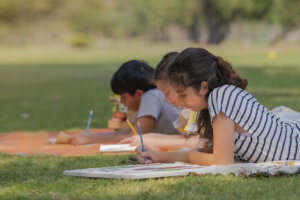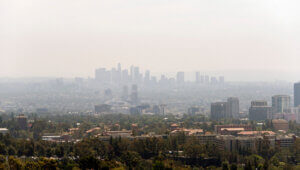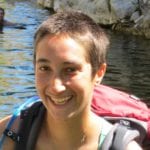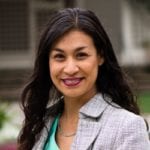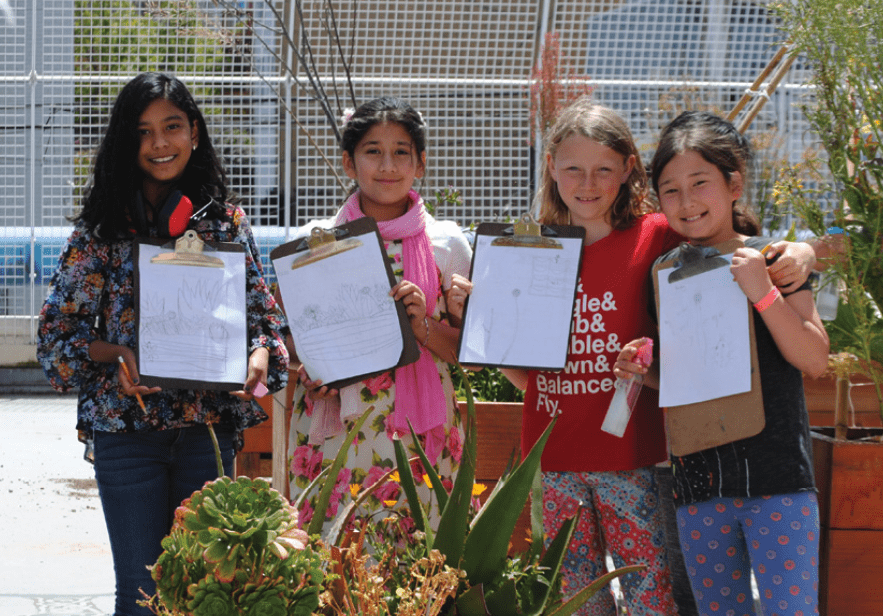Environmental literacy is about helping young people harness a powerful sense of connection with their surroundings and each other. We cannot advance the movement for impactful, environment-based education in California (the nation’s most racially diverse state) without addressing the interconnectedness of racial justice and outdoor and environmental education.
In service of CAELI’s commitment to centering equity and justice throughout the environmental literacy field, we are highlighting the partnership between Youth Outside and BEETLES at the Lawrence Hall of Science, UC Berkeley, which is improving the quality and cultural relevance of outdoor science education. Youth Outside, an Oakland-based organization with a national impact advances racial justice and equity in the outdoor and environmental movement by shifting resources to, building power with, and centering the voices and leadership of Black, Indigenous, and people of color. The BEETLES Project aims to support student- and nature-centered teaching and learning through capacity building, professional learning, and resource publication.
Since 2017, the partnership between BEETLES and Youth Outside resulted in several publications and new opportunities for environmental education organization leaders. Currently, applications are open for a new workshop series, Working Towards Racial Equity, which is being co-designed and facilitated by Youth Outside and BEETLES.
In this Q&A, we hear from three of these project leaders about the partnership between Youth Outside and BEETLES, and how it’s helped them remove barriers that have historically prevented communities of color from accessing meaningful experiences in nature.
- Laura Rodriguez is the program director at Youth Outside. She designs and implements programs that support increased racial equity, inclusion, and cultural relevance within the outdoor and environmental field.
- Jedda Foreman is the director of environmental literacy programs at the Lawrence Hall of Science, UC Berkeley, which includes leading the BEETLES project.
- Emilie Lygren is a professional developer and curriculum specialist at BEETLES. Emilie is an educator, facilitator, and poet who has co-authored dozens of publications focused on outdoor science education.
Why is environmental literacy important to you, and how does the work you do support that mission?
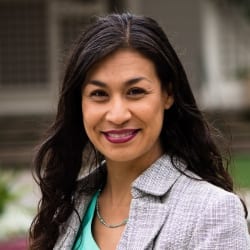
Laura: Environmental literacy is important to me individually and to Youth Outside because it is a building block toward a greater depth of relationship with the planet. Environmental literacy is important for young people in particular to have, not because they don’t already have a relationship with the environment, but so they can be fully aware of what they already know and what more they can learn.
Environmental literacy is often presented to young people as something that lives separately from all other interrelated issues of our lives, including environmental justice. For us, it is important that folks have meaningful experiences in the outdoors so they can get excited about the relationships they have with the planet. Youth Outside advances racial justice and equity in the outdoor and environmental movement by shifting resources to, building power with, and centering the voices and leadership of Black, Indigenous, and people of color who for far too long have been left out of the environmental narrative.
Jedda: Like Laura, I feel lucky to work on something that feels crucial to me personally and professionally. The BEETLES Project emerged from research on high quality teaching and learning in formal education settings, layered onto the many documented benefits of being outdoors and having a connection to nature, such as providing stress relief and cultivating a sense of place. We believe that one pathway to environmental literacy develops by exploring that connection to nature through a lens of scientific thinking. Being able to think like a scientist helps us all to be critical consumers in the world and engaged citizens of the planet, and, therefore, we are more equipped to work towards justice. BEETLES is a capacity building system that supports organizations, managers, educators, and other stakeholders to create and advocate for student- and nature-centered teaching and learning.
Emilie: The role of science is critical within the context of global issues like climate change, COVID-19, and pollution. Many of these issues have disproportionate impacts on marginalized communities, and science is one tool that has been used to confront these challenges. However, in the academic context, science is often represented as a list of facts to memorize, as opposed to a way of thinking and a set of attitudes for engaging in collaborative discovery. Through our activities, teaching approaches, and resources, BEETLES strives to frame science as a set of skills, and one way of thinking that can play a key role in supporting students to develop environmental literacy.
What does the partnership between the BEETLES Project and Youth Outside look like?
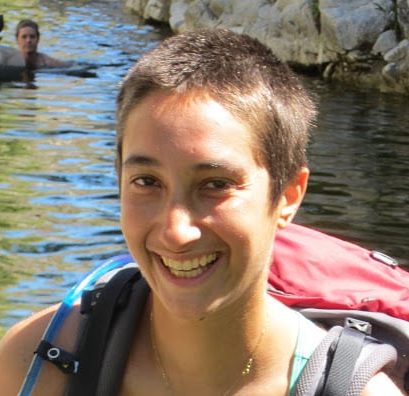
Jedda: The partnership started several years ago when we invited Rena Payan from Youth Outside to attend a BEETLES workshop. Afterwards, we had a great conversation about the work that both of our organizations do, and Rena gave us some suggestions that changed the way we thought about aspects of our materials and instruction. That conversation stuck with us for years afterward, and so we felt really motivated to build a formal partnership with Youth Outside. We sought out opportunities and funding to work with Youth Outside, building trust and deepening relationships as we went. Gradually, over several years, it has grown into the multi-faceted partnership that it is now.
Now, as partners, Youth Outside and BEETLES work together in many ways, including collaboratively doing research and writing publications to influence the field (such as this one about re-establishing the field and co-designing and leading capacity building and professional learning opportunities (like this one, we just opened applications for). We’re also thinking together about how we can, on a national scale, create regional collaboratives that hold equity as a central component to advance the field of outdoor science. Last year, we asked Youth Outside to review and provide feedback on some of our materials, which has resulted in new ways of thinking and the revision and republication of several student activities (a process we documented in this blog).
BEETLES has been working to revise materials through a more culturally relevant and inclusive lens. How did this journey first get started?

Emilie: This journey began with a realization of how much we didn’t know and the expertise we lacked as a team. We knew that our goal was to offer meaningful and culturally relevant experiences to foster support for learning and growth among students, but we realized how much room we had to learn as a team and wanted to get support. We trusted that Youth Outside would tell us what we were doing wrong; they would offer ideas and be willing to bring in their expertise to help us support our goals in a more substantial way.
Laura: I want to offer some context for Youth Outside’s approach in supporting the BEETLES team because at Youth Outside, it is important for us to offer suggestions without necessarily framing our feedback as outlining what is right or wrong. There is much to learn and there are many opportunities for growth for all of us, even those who folks might call an expert.
On the other side of learning is the unlearning. It is OK to be the educator and not know. It is OK to learn with and from our students. I have a hard time with the idea of expertise because it leads people to think they must always have the answers. It is important, rather, to take the approach of being OK with not knowing everything in order to step into community and model discovery rather than position oneself as the person who has all the answers.
Emilie: The idea that the educator is also a learner is extremely valuable. Since the BEETLES project started, one of our core beliefs has been that as educators, we should be learning and growing with our students, and not positioning the instructor as the only expert. And yet, in our activities and resource materials, there were so many ways that the language we were using to describe our instruction was actually reinforcing these power dynamics. This has been a place where Youth Outside has pushed our thinking and supported us.
Can you share more about what you have learned about writing culturally relevant materials?
Jedda: We’ve also learned some important lessons about de-centering instructor expertise and how we make sure we’re using language that honors participants’ and learners’ lived experiences as a form of expertise. We need to make sure that we learn from learners, and learners learn from each other, and learners have time to reflect on their own experience and their own relationship with nature. There were subtle ways that the misguided positioning of expertise was showing up in our program materials. By merely telling and explaining things to students, we weren’t honoring what they might already know or even how they might process information. We also had deficit-based language throughout our activities that we really hadn’t realized, where we were just assuming that kids were coming with a certain set of experiences with nature, or didn’t know about scientific thinking, or didn’t know how to connect with nature. We were assuming it was easy for them to get bored in nature. What that ignored was that these students already had a relationship with nature in some form, no matter how old they were.
Emilie: Another big one I am still working on with myself is ableist language and how we use language that ties an action to a certain ability. That’s something that I am noticing in my own language all the time. Unlearning ableist language is an important area of growth for us and for the field at large.
How has this partnership changed your internal practices and the way you support other organizations?
Jedda: Something we learned early on was that we needed to be more clear about what we meant when we talked about equity, inclusion, and cultural relevance. In effect, we were just throwing those words around without specifying how we were defining them, which, of course, hampered our capacity to do any of that work really well. So that launched us on a process to figure out how we were defining those essential terms and talk about how to incorporate them into our design principles. We did this to make it incredibly clear how we saw ourselves and how we wanted to build every material and every workshop, so that the equity work could be a core part of our mission, not a sort of add-on or bonus.
Laura: Over the course of our relationship with the Lawrence Hall of Science, one of the things we’ve seen is a shift in the way that relationships with partners are held and developed, all in great ways. It’s been a tangible outcome for us to “walk the talk” of modeling inclusion, equity, and humility. We’ve really been thinking about the broad 360 surrounding any situation, as we consider how to be a partner in a way that is mutually beneficial to all of the external partners.
Youth Outside has really supported organizations in understanding and embracing that there is no universal checklist of “things to do.” Reading all of the theory doesn’t yield the ability to achieve equity or inclusion. This work of being intentional, inclusive, and working toward equity is about putting theory into action. We want organizations to make that connection as quickly as possible.
We also frame our work with organizations by expressing that equity and inclusion work does not exist outside of us as individuals. If we think we are going to embrace these efforts as this external thing that has nothing to do with us, or that it won’t challenge us, or put us in a place of growth, we’re mistaken. You are in for an unexpected jolt if that is how you are thinking about this work.
Looking ahead, what goals do you have for your organizations and the environmental literacy field as a whole?
Jedda: Something that comes to mind is creating space for the environmental field to talk about racism. Racism has been a part of the history of science that has gone unacknowledged for many decades. The dominant narrative of how the environmental movements took off in the United States is particularly steeped in the oppression of people of color and Indigenous folks.
The work that we are doing in the equitable organizations pilot workshop is around re-imagining the workplace and asking what practices and systems maintain white supremacy among environmental education organizations. There is a lot of focus in the field around hiring practices and, of course, hiring practices are important, but we have to start with the work environment. And we can’t hire people into a work environment that’s going to end up causing them more harm.
Because the fields’ history is steeped in racism, the field is defined in terms of what white middle-aged men wanted it to look like back in the early part of the last century. We want to work toward redefining the field to include environmental justice and community building.
Emilie: Connecting to what Laura shared about how equity and inclusion work doesn’t exist outside of us as individuals, one hope I have for the field is that a commitment to growth is imbued into every part of our work. There can be an assumption that becoming an excellent instructor is a destination one can arrive at, as opposed to an ongoing process of growth, learning, and reflection. I hope educators and organization leaders across the field are committed to growing and learning as practitioners.
Another thing I hope the field takes on in a significant way is engaging community advisory boards in the design of student experiences. We need to include student voices and community voices in the design from the very beginning, not just at the end.
Laura: One of the goals for Youth Outside is that we do more to elevate and celebrate the voices and the leadership of Black, Indigenous, and people of color within the environmental literacy field, and to bridge the separation from environmental justice, which both Jedda and Emilie have been talking about. Environmental literacy cannot exist as a field outside of its relationship to racial justice and equity.
It is paramount to expand what it means to be in relationship with environmental literacy. Because when we do, the movement will be better able to recognize the leadership of Black, Indigenous, and people of color and dismantle the narrative that folks aren’t in relationship to the world they live in and sustains them.
More Resources
- Working Towards Racial Equity Workshop Series (Applications currently open) — The Lawrence Hall of Science and Youth Outside are launching their Working Towards Racial Equity workshop series. This two-year series will support environmental and outdoor science organizations to foster racial equity and cultural relevance in their work.
- Examining Equitable and Inclusive Work Environments in Environmental Education — “This study, led by the Research Group at the Lawrence Hall of Science, was commissioned as part of a planning grant, funded by the Pisces Foundation, to support the design of a professional learning workshop series for outdoor science organizations.”
- Building Towards an Inclusive Organizational Culture: Insights and Lessons Learned from YES Nature to Neighborhoods — “This brief highlights YES Nature to Neighborhood’s reflective journey in transforming their organizational culture to intentionally tend to the ways their systems and practices can foster the promotion and retention of Black, Indigenous, and people of color (BIPOC) in the organization.”
- Intentional Hiring and Recruitment through the Lens of Equity and Inclusion — “This brief provides an example of the introspection, intention, and attention to detail of the Crissy Field Center at the Golden Gate National Parks Conservancy, during its journey toward a workforce that reflects the youth they serve and their organization-wide core values of equity and inclusion.”
- Racial Equity in Outdoor Science and Environmental Education: Re-Establishing the Field with Intention — “Here are seven ideas for white-led organizations to join the effort in transforming the environmental education field to a new way of being that is rooted in racial equity and has justice embedded at every inflection point.”
- “Revising Making Observations: Striving for Equity, Inclusion, and Cultural Relevance” — Here, the BEETLES Project reintroduces their flagship professional learning session, Making Observations. Using the framework for revisions developed with Youth Outside and with additional support from Annie Sorrell of the Center for Native Peoples and the Environment and her cohort of graduate students, the BEETLES team has integrated indigenous perspectives on science and connection to nature and the outdoors into the session.
- “Partnering to Develop Equitable, Inclusive, and Culturally Relevant Student Activities” — In this blog post, Emilie Lygren and Jedda Foreman document the BEETLES team’s process in revising and designing student activities that specifically address equity, inclusion, and cultural relevance.



